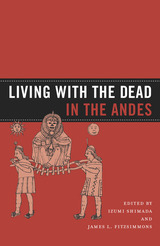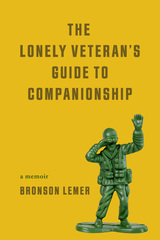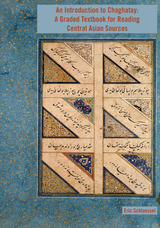
An Introduction to Chaghatay is the first textbook in over a century to introduce this language to English-speaking students. This book is designed to build a foundation in reading Chaghatay without assuming any background knowledge on the part of the reader. These graded, cumulative lessons include common vocabulary, accessible grammar explanations, and examples of Chaghatay manuscripts. Authentic texts introduce the student to different genres, including hagiographies, documents, “stories of the prophets,” and newspapers while introducing critical skills in paleography.
Eric Schluessel is Assistant Professor of Chinese History and Politics at the University of Montana. He holds a PhD in History and East Asian Languages from Harvard University, an MA in Linguistics from the School of Oriental and African Studies, and an MA in Central Eurasian Studies from Indiana University. He is the author of several articles on the history of Chinese Central Asia and is currently preparing a critical edition and translation of Mullah Musa Sayrami’s Tarikh-i Hamidi, a chronicle of Xinjiang in the nineteenth century.

Kazakh, a Turkic language that uses Cyrillic script, is the official state language of Kazakhstan and is also spoken by people in parts of China, Russia, and neighboring Central Asian countries. This unique learner’s dictionary features simple definitions, literal translations, English equivalents, full example sentences, and grammar and usage for over 2,000 Kazakh idioms.
As students progress to the upper-intermediate and advanced levels of language learning, they come in contact with cultural concepts embedded in simple words that they have learned as part of everyday vocabulary. Thus, they expand their vocabulary into idiomatic expressions. Upper-intermediate and advanced learners of Kazakh will find this extensive reference work useful to understand those culturally bound idioms.
Idioms in this reference volume are organized into categories—the human body, food, clothing, color, number, animals, and nature—that best represent the topics on which language learners focus at the beginning and intermediate levels of language study. Five indexes make finding the idiom you want—by idiom, keyword, or expression in both Kazakh and English—easier.
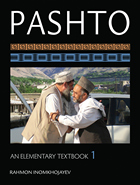
eTextbooks are now available to purchase or rent through VitalSource.com! Please visit VitalSource for more information on pricing and availability.
Pashto, designated a critical language by the US Department of Defense, is one of two official languages of Afghanistan and is also spoken in parts of Pakistan. Volume 1 of Pashto: An Elementary Textbook is designed to cover one semester of beginning-level language instruction; together, Volumes 1 and 2 of Pashto cover one year of instruction. The textbook provides learners and instructors with a wide selection of task-oriented, communicative language materials to facilitate the development of language learning. It features a functional approach to grammar, an emphasis on integrated skills development, and the use of authentic materials.
The activities provided in the textbook will help learners to develop strong skills in speaking, listening, reading, and writing. In addition to the cultural background embedded in the video materials, the textbook contains cultural notes that improve competency.
Volumes 1 and 2 of Pashto: An Elementary Textbook each include:• Authentic audio and video materials to accompany the text, available on the Press website• Extensive Pashto–English and English–Pashto glossaries• Material for teaching the Arabic-based Pashto alphabet • Color illustrations and photographs throughout
Topics coveredVolume 1 (first semester): The Pashto alphabet, writing, reading, pronunciation, greetings and introductions, university life, daily activities, in the city, and family
Volume 2 (second semester): Seasons, weather, holidays, health, food, sport, and shopping
For Instructors: Exam copies of the textbook are available free of charge to instructors and can be ordered on this page. To request a print sample, please use the "print" exam copy button. Instructors may request a digital sample by logging into VitalSource.com, selecting "Faculty Sampling" in the upper right-hand corner, and selecting the desired product.
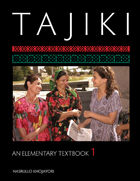
Tajiki, a variety of modern Persian spoken in Central Asia, is the official language of Tajikistan; most speakers of Tajiki live in Tajikistan and Uzbekistan. Volume 1 of Tajiki: An Elementary Textbook is designed to cover the first semester of beginning-level language instruction; together, Volumes 1 and 2 of Tajiki cover one year of instruction. Each volume of Tajiki: An Elementary Textbook uses the latest pedagogical thinking to teach basic communication skills and linguistic forms in their cultural context. Tested in the classroom, Tajiki enhances students' exposure to the language by providing the only authentic video and audio available in Tajiki. Each volume contains a CD-ROM that includes authentic audio and video materials to accompany the text and extra exercises, all in Flash format and all of which are keyed to the textbook. Each book also includes an extensive glossary, maps of the world labeled in Tajiki, and four-color illustrations and photographs throughout.
Topics CoveredVolume One (first semester): Greetings, the Tajiki alphabet, the classroom, professions, introductions, nationalities and places of origin, weather, telling time, family, money, food
Volume Two (second semester): Sports, cooking and ordering meals, clothing, travel, months, seasons, holidays, body parts, medicine, university life, housing (city and village), regions and religions of Tajikistan
Minimum System Requirements
• Intel Pentium II 450 MHz or faster processor (or equivalent); Mac OS 10.4 or higher• 128 MB of RAM• CD Drive• Speakers or headphones
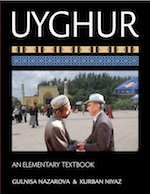
The Uyghurs are one of the oldest Turkic-speaking peoples of Central Asia. Their language is closely related to Uzbek, with which it shares a common ancestor. Modern Uyghur is spoken by about 11 million people in Xinjiang and 2 million people in Central Asia and elsewhere. This textbook offers beginning students a thematically organized and integrative approach to the Uyghur language that emphasizes communicative activities, step-by-step development of linguistic skills, and elements of Uyghur culture. A multimedia DVD includes audio that helps develop listening and speaking skills and videos filmed in different regions of Xinjiang, China.
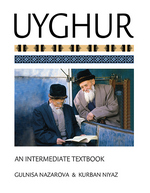
Uyghur: An Intermediate Textbook offers students, professionals, and travelers alike the preeminent tool for expanding their knowledge of the Uyghur language and culture. Combining innovative language learning methodology with authentic audio and video materials, this textbook develops the four primary language skills—speaking, listening, reading, and writing—by integrating them into a clear, balanced whole.
Uyghur: An Intermediate Textbook prepares learners to perform at level 1+/2 or 2+ on the ILR scale and at the Intermediate High to Advanced Mid/High levels on the ACTFL scale.
Features include:
* A multimedia CD that contains videos filmed on location as well as both authentic and scripted audio segments, all highlighting key elements of Uyghur culture
* Authentic original and modified reading passages ranging from short stories to news articles to menus
* Abundant cultural notes to reinforce reading, grammar, and vocabulary skills
* Easy-to-understand examples and exercises on points of Uyghur grammar
* Chapter themes that facilitate immersion in daily Uyghur life and culture
Designed for both classroom and on-the-ground learners, and developed in accordance with the latest ideas in performance-based principles and methodology, Uyghur: An Intermediate Textbook guides readers on a journey to the heart of a fascinating culture.
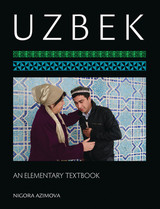
Designed to cover beginning college levels of language instruction, Uzbek: An Elementary Textbook provides learners and instructors with a wide selection of materials and task-oriented activities to facilitate the development of language learning. It offers a thematically organized and integrative approach to the Uzbek language and its culture, including a functional approach to grammar, an emphasis on integrated skills development, and the use of authentic materials such as videos filmed in various regions of Uzbekistan.
This volume includes -authentic audio and video materials, available for free on GUPTextbooks.com-an extensive glossary-color illustrations and photographs throughout Topics CoveredThe Uzbek alphabet, greetings and introductions, commands and requests, daily routines, etiquette, weather, family, money, food, clothing, travel, leisure, and medical matters.
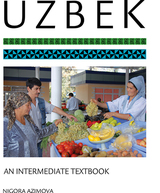
Using a wide selection of materials and task-oriented activities drawn from realistic situations and contexts, Uzbek: An Intermediate Textbook, is designed to help adult professional and higher education learners deepen their understanding of the Uzbek language, culture, and its people. Learners will develop listening, reading, speaking, and writing skills, with special attention to grammatical accuracy. With a variety of texts, audio clips, videos, and activities, this textbook will encourage learners to explore Uzbek culture and to compare and contrast it with their own.
Uzbek: An Intermediate Textbook prepares learners to perform at level 1+ or 2 on the ILR scale and at the Intermediate High or Advanced Low level on the ACTFL scale.
Features of Uzbek: An Intermediate Textbook:-Topics covered include work, study, personal interests, and travel.-Authentic audio and video materials to accompany the text, available for free on GUPTextbooks.com-The book uses the Cyrillic alphabet—the alphabet used in current government reports and the mass media as well as in archival material from the Soviet era.-A useful appendix compares the Cyrillic alphabet with the Latin alphabet.-Uzbek-English and English-Uzbek glossaries facilitate vocabulary acquisition.
READERS
Browse our collection.
PUBLISHERS
See BiblioVault's publisher services.
STUDENT SERVICES
Files for college accessibility offices.
UChicago Accessibility Resources
home | accessibility | search | about | contact us
BiblioVault ® 2001 - 2025
The University of Chicago Press





